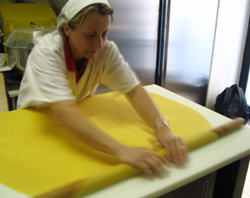by Katherine Harrington
Hundreds of colorful postcards with destinations from Dubai to Tucson, Ariz., cover the walls of the small Pasta Fresca, or fresh pasta shop. Loris Lepri, the owner,has not traveled to all of the places, but he receives postcards from loyal customers and friends as they travel around the world. It seems that no matter how far people's travels take them, Pasta Fresca, and Loris Lepri in Cagli are never far from their thoughts.
When Lepri's mother first came to Cagli from Gubbio about 40 years ago to live with her husband, she made pasta only for her own family. Then she began making pasta for restaurants around town until the family bought a house on Atanagi Street. They converted the bottom floor of the house into a pasta store. Lepri's mother began selling her homemade pasta to the people of Cagli in 1972. In the beginning, all of the pasta was handmade every day. Eventually, the family began buying machines to do some of the work. years ago to live with her husband, she made pasta only for her own family. Then she began making pasta for restaurants around town until the family bought a house on Atanagi Street. They converted the bottom floor of the house into a pasta store. Lepri's mother began selling her homemade pasta to the people of Cagli in 1972. In the beginning, all of the pasta was handmade every day. Eventually, the family began buying machines to do some of the work.
As a child, Lepri helped his mother in the store with the cash register during the summer breaks. Today, Lepri arrives at his store at 7 a.m. every day except Mondays to begin making pasta for the people of Cagli. He has taken over as owner of the small store, but his mother, Silvana, still makes pasta every day.
The small store contains a single case displaying six or seven trays of various kinds of pasta. Lepri ex plained that the most popular kinds of pasta are cappelletti, which are squares of pasta filled with mixture of pork and beef, and tagliatelle, which are long, thin pieces of pasta similar to spaghetti, which Lepri makes throughout the day as supplies run low. plained that the most popular kinds of pasta are cappelletti, which are squares of pasta filled with mixture of pork and beef, and tagliatelle, which are long, thin pieces of pasta similar to spaghetti, which Lepri makes throughout the day as supplies run low.
Lepri provides 40 to 50 Cagliesi a day with fresh pasta, but where does every one else in town buy their pasta?
Small regional pasta factories provide selections of fresh pasta to grocery stores, an industry known as pastifici . The grocery stores also carry processed, dried pasta similar to the pasta found throughout the world.
Freshly made pasta is more expensive than the processed pasta found in the grocery store, but most customers think the difference in taste is well worth the cost. More people come in on the weekends, about 100 each Saturday and Sunday because custom ers have more time to cook on weekends. The pasta is sold per kilo, and the cost ranges from 10 to 12 euros per kilo. ers have more time to cook on weekends. The pasta is sold per kilo, and the cost ranges from 10 to 12 euros per kilo.
Older women provide the majority of Lepri's customers. "The older women are accustomed to the tradition of fresh pasta every day," he said.
The pasta is made with fresh eggs and no preservatives, which provides its delicious flavor. Lepri keeps a pile of pasta scraps in the corner of his store to feed to the local dogs that roam the streets of Cagli.
While buying pasta at the grocery store is convenient, it lacks the atmosphere of the local, handmade-pasta store that Lepri provides. Like most Cagliesi Lepri does not seem to be worried about competition from the grocery store. "Competition? No. This pasta is fresh," Lepri said  with a smile. with a smile.
Lepri develops a relationship with his customers and was eager to invite us for a behind the scenes look at how he and his crew make pasta every day. As I watched in amazement at the two women rolling out dough to make cappelletti, Lepri came behind me and draped an apron over my head. He then showed me how to make one of the most poular types of pasta, which looks like gnocchi stuffed with meat. My fingers fumbled over every piece I attempted to make while next to me Lepri nimbly whipped out twice as many of the tiny pasta as I did. "You work for us and we'll feed you pasta for pausa ," said Lepri.
Story by Katherine Harrington
Photos by Allison James
Video by Lauren O'Connell
Web Design by Elizabeth Samolis
[ECONOMY] [HOME]
|
